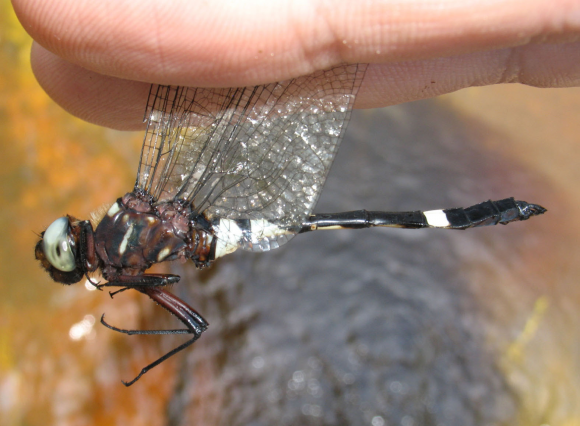Genus Zygonyx Hagen, 1867
cascaders
Synonyms:
- scientific: Pseudomacromia Kirby, 1889 [torrida]; Schizonyx Karsch, 1890 [luctiferus]; Schizothemis Sjöstedt, 1900 [flavicosta]; Homothemis Sjöstedt, 1909 [meruensis = natalensis]; Tilithemis Sjöstedt, 1917 [lindblomi = natalensis]
Type species: Zygonyx ida Selys, 1869
Introduction
The genus includes at least twelve Afrotropical and about five Asian species, all favouring fast-flowing water. Unlike most libellulids, Zygonyx species rarely rest by the waterside, and perch in a hanging position. The most common species, Z. natalensis and Z. torridus, are often found hovering above open rapids and waterfalls. The former in particular can be numerous over rushing white water, while the latter is the only one to commonly occur in dry areas and on temporary waters. The other species favour more forested habitats, with Z. atritibiae, Z. chrysobaphes, Z. regisalberti and presumably Z. speciosus males patrolling relatively calm stretches, and Z. dionyx and Z. geminuncus deeply shaded ones. Z. flavicosta is the typical species of exposed falls in forested landscapes, but appears to be a species complex: Z. annika from large river rapids in Sierra Leone and Z. denticulatus of Zambezian streams and rivers were separated recently, but more species may exists, e.g. on hard to sample large rivers. Zygonyx males are (very) large (hindwing 37-61 mm) and diverse in appearance, although generally dark with conspicuous markings: e.g. Z. torridus has 6-7 buff abdominal rings, Z. natalensis is thickly grey pruinose on thorax and abdominal segments 7-9, Z. flavicosta and its relatives are black with contrasting yellow markings, and Z. atritibiae and Z. regisalberti rather brown with some bold cream marks on thorax and abdomen. Abdomen shapes also vary greatly, being tapered in Z. torridus, clubbed in Z. atritibiae and Z. regisalberti, and only thickened somewhat distally in the other species. Males have (largely) clear wings, but the females of some species have broad wings with striking (though very variable) patterns and may fly about conspicuously. The spectacular Z. eusebia female is Africa’s largest libellulid. [Adapted from Dijkstra & Clausnitzer 2014]
Diagnosis
Male of genus is similar to Trithemis by (a) hindlobe of prothorax small, roughly semicircular and widest at base (dorsal view), apex often pressed downwards (lateral view), its border with short hairs and at most a few longer hairs; (b) sectors of arculus in Fw always fused at base, separating well distal to arculus; (c) 8½-19½ Ax in Fw (‘½’ indicates often incomplete distal Ax); (d) arculus often closer to Ax2, sometimes even distal to it; (e) Fw discoidal field narrows terminally, number of rows just before end about equal to that at base, e.g. 3 and 4; (f) legs and often labium marked with black; (g) hook of hamule large, prominently apical; anterior lamina high, about as large as genital lobe; (h) S4 without transverse ridge, although colour pattern or scar-like seam may indicate its position, there is no ridge of similar magnitude as transverse ridge of S3 and lateral carina of S4. However, differs by (1) larger size, Hw 35-61 mm; (2) 1 cell-row in radial planate if 2 Hw over 40 mm; (3) posterior hook of tarsal claws at least quarter of size of anterior hook, often both about equally large. [Adapted from Dijkstra & Clausnitzer 2014; this diagnosis not yet verified by author]

Zygonyx flavicosta (Sjöstedt, 1900). Male © Jens Kipping
Map citation: Clausnitzer, V., K.-D.B. Dijkstra, R. Koch, J.-P. Boudot, W.R.T. Darwall, J. Kipping, B. Samraoui, M.J. Samways, J.P. Simaika & F. Suhling, 2012. Focus on African Freshwaters: hotspots of dragonfly diversity and conservation concern. Frontiers in Ecology and the Environment 10: 129-134.
References
- Lieftinck, M.A. (1963). The type of Libellula hova Rambur, 1842, with notes on the other species of Zygonyx Selys from Madagascar. Verhandlungen der Naturforschenden Gesellschaft in Basel, 74, 53-61. [PDF file]
- Pinhey, E. (1964). Dragonflies (Odonata) of the Angola-Congo borders of Rhodesia. Publicacoes Culturais Companhia de Diamantes de Angola, 63, 95-129. [PDF file]
- Dijkstra, K.-D.B. (in prep.) Odonata of the Congo: checklist, bibliography, gazetteer, new records, species descriptions, and taxonomic notes with an emphasis on Elattoneura, Mesocnemis and Congothemis. Zoologische Mededelingen. [PDF file]
- Ris, F. (1921). The Odonata or Dragonflies of South Africa. Annals South African Museum, XVIII, 245-452. [PDF file]
- Pinhey, E.C.G. (1961). Dragonflies (Odonata) of Central Africa. Occasional Papers Rhodes-Livingstone Museum, 14, 1-97. [PDF file]
- Barnard, K.H. (1937). Notes on dragon-flies (Odonata) of the S. W. Cape with descriptions of the nymphs and of new species. Annals South African Museum, 32, 169-260. [PDF file]
- Fraser, F.C. (1955). Odonata. Exploration Parc National Upemba. Mission G F de Witte, 38, 1-34. [PDF file]
- Sjöstedt, Y. (1909). Wissenschaftliche Ergebnisse der schwedischen zoologischen Expedition nach dem Kilimandjaro, dem Meru und den umgebenden Massaisteppen Deutsch-Ostafrikas 1905-1906 unter Leitung von Prof. Dr. Yngve Sjöstedt. 14. Pseudoneuroptera. Odonata, 14, 1-52.
Citation: Dijkstra, K.-D.B (editor). African Dragonflies and Damselflies Online. http://addo.adu.org.za/ [2024-10-30].


